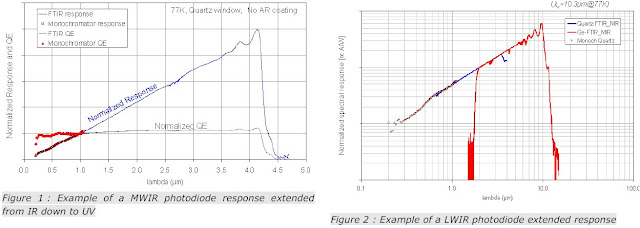Some time ago Banpil came with a bold statement of knowing a way to build broad spectrum imagers, claimed "to be manufactured by using conventional semiconductor process":
Now Banpil says that the patents on this technology have have been granted. While the company does not give the patent numbers, it appears to be US8174059 and US8101971 patents, offering a stack of InGaAs photoabsorption layer on GaAs or InP substrate:
The photodiode has n type InP substrate 10, n+ and low doped InAs(y)P(1-y) buffer layers 11, InAs(0.6)P(0.4) layer 13, In(0.8)Ga(0.2)As layer 15 as absorption layer, highly doped InAs(0.6)P(0.4) layer 17 for ohmic contact. Photodiode has the n type ohmic contact 20 at the backside of the substrate 10, and p type of ohmic contact 22 at the top of the photodiode.
The patent's abstracts sound almost like an ad: "Novel structures of the photodetector having broad spectral ranges detection capability are provided. The photodetector offers high quantum efficiency >95% over wide spectral ranges, high frequency response >10 GHz (@3 dB). The photodiode array of N x N (or M x N) elements is also provided. The array also offers wide spectral detection ranges ultraviolet to 2500 nm with high quantum efficiency >95% and high frequency response of >10 GHz, cross-talk of <0.1%. In the array, each photodiode is independently addressable and is made either as top-illuminated or as bottom illuminated type detector. The photodiode and its array provided in this invention, could be used in multiple purpose applications such as telecommunication, imaging, and sensing applications including surveillance, satellite tracking, advanced lidar systems, etc. The advantages of this photodetectors are that they are uncooled and performance will not be degraded under wide range of temperature variation."
Banpil has made sample-level sensor array products available for demonstration by request.
Leti Annual Research Report 2011 too presents multispectral imagers based on n on
p photodiodes implanted in a thin HgCdTe film (few μm) grown on CdZnTe substrate (see p. 15). Leti managed to extend their spectral response from the usual LWIR band all the way to 250nm UV:
On p. 36 Leti presents its work on Fabry-Perot RGB filters with nice looking color separation graphs, sans somewhat low peak transmission:




I wonder how the FP filters shift in wavelength peak when the incident angle is not normal?
ReplyDeleteR, G and B filers shift by 10-20nm at 30° incidence resulting in color error but small loss of sensitivity. The color error can be minimized using a color correction matrix with spatially variable coefficients.
DeleteRelated article: L. Frey, P. Parrein, J. Raby, C. Pellé, D. Hérault, M. Marty, J. Michailos, Opt. Expr. 19 (2011) 13073